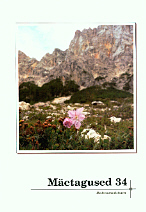Tütarlapsest sirgub naine. Hoiatusjutud tütarlastele populaarses meditsiinikirjanduses
"A Girl Becomes a Woman". Cautionary Tales for Young Girls in Popular Medical Literature
Author(s): Andreas KalkunSubject(s): Customs / Folklore
Published by: Eesti Kirjandusmuuseum
Keywords: didactic literature; popular scientific medicinal literature; puberty; gender ideologies; health education in Estonian SSR; true experience stories
Summary/Abstract: A Girl Becomes a Woman (Ene Kook 1978, 1979, 1986) was a widely available publication for young girls. A substantial number of the 47 stories within this book made a great impact on teenage girls in the 1970s and the teaching on women's bodies and hygiene was accepted as common knowledge. The text is illustrated by many stories and these stories actually appear throughout the book and not only in the passages specifically marked as such. In the book there are 47 well-formed tales with a perfectly balanced structure. The tales include certain formulas and structures which recur from story to story. According to the traditions of ethnology, the 47 narratives by Ene Kook can be categorised as exempla or cautionary tales, anecdotes and urban myths. Cautionary tales warn people about the consequences that wrong behaviour may have. These stories usually end with a moral note in which those who have behaved badly receive a just penalty, whether physical or otherwise. Anecdotes are usually based on some comic saying, which at the same time can function as the punch-line to the story. Beside well-developed anecdotes you can find other anecdote-like stories in the book where someone's utterance is the core and punch-line of the story. In these brief stories the sub-clauses may be elliptical and the stories do not contain a moral lesson. A Girl Becomes a Woman is an educational book for young women, in which folklore and medicine meet. The teaching narratives found in the educational text, supposedly from true experience, in essence remind us of folklore texts, and their intended purpose is to teach young women the gender ideologies and taboos related to the human body in the given society. The traditional art of story-telling and old narratives and the established medical truths about female body and how women should behave meet between the covers of A Girl Becomes a Woman. The joining the "high" and "low" for educational purposes and constructing coherent narratives has been done with the intention of influencing the reader. A Girl Becomes a Woman represents the norms and taboos of the society. Despite the academic inclination of the book much of the teaching has been delivered by means of taboos and traditions and gender ideologies rather than actual medical concepts. For example, the book supports the idea that menstruation and feminine sanitary products are considered to be shameful and by doing so stigmatises menstruating women.
Journal: Mäetagused. Hüperajakiri
- Issue Year: 2006
- Issue No: 34
- Page Range: 133-148
- Page Count: 16
- Language: Estonian

